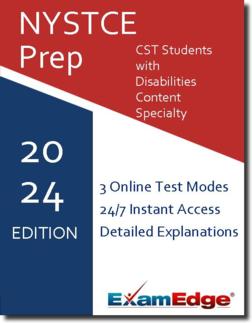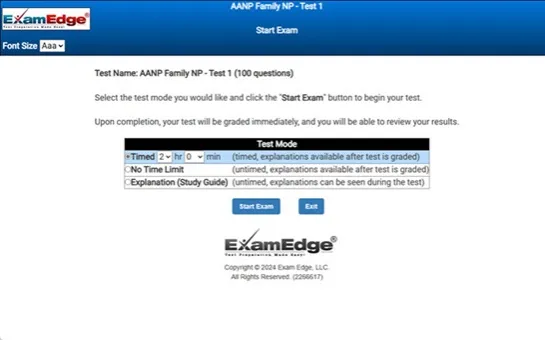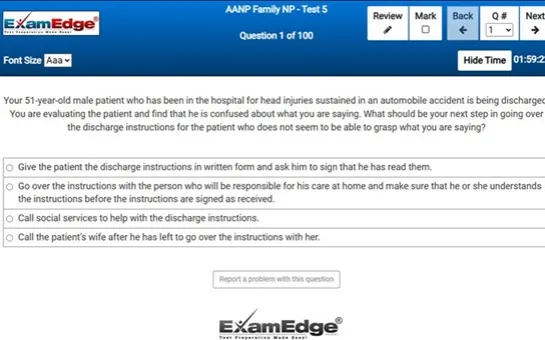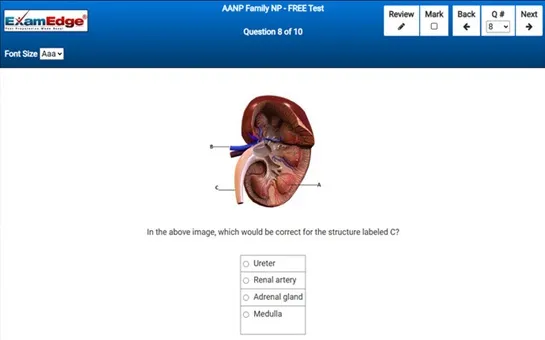NYSTCE CST Students with Disabilities Content Specialty (060) Practice Tests & Test Prep by Exam Edge - FAQ
** Sample images, content may not apply to your exam **
Check out our NYSTCE CST Students with Disabilities Content Specialty FAQs to learn more about the exam, our practice tests, and other information to help you succeed.
Our practice tests are designed to help you master both the subject matter and the art of test-taking. Created to mimic the real exam, our practice tests feature:
- Instant access to your online practice tests - available 24/7
- Timed, untimed, and "study guide" modes
- Detailed explanations for each question
- 20 online practice exams - That's 1,820 unique questions
Not ready to purchase our complete practice tests yet? Start with a NYSTCE CST Students with Disabilities Content Specialty FREE Practice Test first!
Why should I use Exam Edge to prepare for the NYSTCE CST Students with Disabilities Content Specialty Exam?
FAQ's for Exam Edge NYSTCE CST Students with Disabilities Content Specialty practice tests
We have ten great reasons why Exam Edge is the #1 source on the internet when it comes to preparing for NYSTCE CST Students with Disabilities Content Specialty test:
- Comprehensive content: Exam Edge's NYSTCE CST Students with Disabilities Content Specialty practice tests are created specifically to prepare you for the real exam. All our NYSTCE CST Students with Disabilities Content Specialty practice test questions parallel the topics covered on the real test. The topics themselves are covered in the same proportions as the real test too, based on outlines provided by the New York State Teacher Certification Examinations in their NYSTCE CST Students with Disabilities Content Specialty test guidelines.
- Realistic practice: Our NYSTCE CST Students with Disabilities Content Specialty practice exams are designed to help familiarize you with the real test. With the same time limits as the real exam, our practice tests enable you to practice your pacing and time management ahead of test day.
- Detailed explanations: As you complete your practice tests, we show you which questions you answered correctly and which ones you answered incorrectly, in addition to providing you with detailed step-by-step explanations for every single NYSTCE CST Students with Disabilities Content Specialty practice exam question.
- Performance insights: After you complete a practice test, we provide you with your raw score (how many you answered correctly) and our estimate of the NYSTCE CST Students with Disabilities Content Specialty score you would have received if you had taken the real test.
- Ease of access: Because all our practice tests are web-based, there is no software to install. You can take NYSTCE CST Students with Disabilities Content Specialty practice exams on any device with access to the internet, at any time.
- Flexible use: If you must pause while taking one of our practice tests, you can continue right where you left off. When you continue the test, you will start exactly where you were, and with the same amount of time you had remaining.
- Thousands of unique questions: We offer 20 different online practice exams with 1,820 unique questions to help you prepare for your NYSTCE CST Students with Disabilities Content Specialty !
- Low cost: The cost of ordering 5 practice tests is less than the cost of taking the real NYSTCE CST Students with Disabilities Content Specialty test. In other words, it would be less expensive to order 5 practice tests than to retake the real NYSTCE CST Students with Disabilities Content Specialty exam!
- Our trusted reputation: As a fully accredited member of the Better Business Bureau, we uphold the highest level of business standards. You can rest assured that we maintain all of the BBB Standards for Trust.
- Additional support: If you need additional help, we offer specialized tutoring. Our tutors are trained to help prepare you for success on the NYSTCE CST Students with Disabilities Content Specialty exam.
What score do I need to pass the NYSTCE CST Students with Disabilities Content Specialty Exam?
To pass the NYSTCE CST Students with Disabilities Content Specialty test you need a score of 520.
The range of possible scores is 400 to 600.
How do I know the practice tests are reflective of the actual NYSTCE CST Students with Disabilities Content Specialty ?
At Exam Edge, we are proud to invest time and effort to make sure that our practice tests are as realistic as possible. Our practice tests help you prepare by replicating key qualities of the real test, including:
- The topics covered
- The level of difficulty
- The maximum time-limit
- The look and feel of navigating the exam
Do you offer practice tests for other New York State Teacher Certification Examinations subjects?
Yes! We offer practice tests for 62 different exam subjects, and there are 1,140 unique exams utilizing 91030 practice exam questions. Every subject has a free sample practice test you can try too!
NYSTCE Bilingual Education Assessments (BEAs)
NYSTCE BEA Spanish (024)
Practice Tests
NYSTCE Communication and Quantitative Skills Test (CQST)
NYSTCE CQST (80)
Practice Tests
NYSTCE CQST Math (80)
Practice Tests
NYSTCE CQST Reading (80)
Practice Tests
NYSTCE CQST Writing (80)
Practice Tests
NYSTCE Content Specialty Tests (CSTs)
NYSTCE CST Biology (160)
Practice Tests
NYSTCE CST Blind and Visually Impaired (117)
Practice Tests
NYSTCE CST Business and Marketing (069)
Practice Tests
NYSTCE CST Chemistry (161)
Practice Tests
NYSTCE CST Deaf and Hard of Hearing (063)
Practice Tests
NYSTCE CST Earth Science (162)
Practice Tests
NYSTCE CST English Language Arts (003)
Practice Tests
NYSTCE CST ESOL (116)
Practice Tests
NYSTCE CST Family and Consumer Sciences (072)
Practice Tests
NYSTCE CST Gifted Education (064)
Practice Tests
NYSTCE CST Health Education (073)
Practice Tests
NYSTCE CST Library Media Specialist (074)
Practice Tests
NYSTCE CST Literacy (065)
Practice Tests
NYSTCE CST Mathematics (004)
Practice Tests
NYSTCE CST Multi-Subject: Grade 7-Grade 12 (241/242/245)
Practice Tests
NYSTCE CST Multi-Subject: 7-12 Arts and Sciences (245)
Practice Tests
NYSTCE CST Multi-Subject: Grade 7-Grade 12 ELA (241)
Practice Tests
NYSTCE CST Multi-Subject: Grade 7-Grade 12 Math (244)
Practice Tests
NYSTCE CST Multi-subject: Teachers Of Early Childhood EC-2 (211/212/245)
Practice Tests
NYSTCE CST Multi-subject: Teachers Of Early Childhood EC-2 - Arts and Sciences (245)
Practice Tests
NYSTCE CST Multi-subject: Teachers Of Early Childhood EC-2 - Literacy and English Language Arts (211)
Practice Tests
NYSTCE CST Multi-subject: Teachers Of Early Childhood EC-2 - Math (212)
Practice Tests
NYSTCE CST Multi-subject: Teachers Of Childhood 1-6 (221/222/245)
Practice Tests
CST Multi-subject: Teachers Of Childhood 1-6 ELA (221)
Practice Tests
CST Multi-subject: Teachers Of Childhood 1-6 Math (222)
Practice Tests
NYSTCE CST Multi-subject: Teachers Of Students with Disabilities
Practice Tests
CST Multi-subject: Teachers Of Middle Childhood 5-9 (231/232/245)
Practice Tests
CST Multi-subject: Teachers of Middle Childhood 5-9 ELA (231)
Practice Tests
CST Multi-subject: Teachers of Middle Childhood 5-9 Math (232)
Practice Tests
NYSTCE CST Physical Education (076)
Practice Tests
NYSTCE CST Physics (163)
Practice Tests
NYSTCE CST Social Studies (115)
Practice Tests
NYSTCE CST Spanish (129)
Practice Tests
NYSTCE CST Students with Disabilities Content Specialty (060)
Practice Tests
NYSTCE CST Visual Arts (167)
Practice Tests
NYSTCE Liberal Arts and Sciences Test (LAST)
NYSTCE LAST - liberal arts and sciences (001)
Practice Tests
NYSTCE Safety Net
Safety Net ESOL CST (022)
Practice Tests
Safety Net Blind and Visually Impaired CST (962)
Practice Tests
NYSTCE Safety Net Business and Marketing CST (969)
Practice Tests
NYSTCE Safety Net Deaf and Hard of Hearing CST (963)
Practice Tests
NYSTCE Safety Net English Language Arts CST (903)
Practice Tests
Safety Net Family and Consumer Sciences CST (972)
Practice Tests
NYSTCE Safety Net Gifted Education CST (964)
Practice Tests
NYSTCE Safety Net Health Education CST (973)
Practice Tests
NYSTCE Safety Net Library Media Specialist CST (974)
Practice Tests
NYSTCE Safety Net Literacy CST (965)
Practice Tests
NYSTCE Safety Net Mathematics CST (904)
Practice Tests
NYSTCE Safety Net Multi-Subject CST (902)
Practice Tests
NYSTCE Safety Net Physical Education CST (976)
Practice Tests
Safety Net Students with Disabilities CST (960)
Practice Tests
NYSTCE Safety Net Technology Education CST (977)
Practice Tests
NYSTCE Safety Net Visual Arts CST (079)
Practice Tests
NYSTCE Technology Education (118)
Practice Tests
NYSTCE School Leadership Assessments (SLA)
NYSTCE School Building Leader (107,108)
Practice Tests
NYSTCE School District Leader (103,104)
Practice Tests
NYSTCE Tests for Teacher Certification
NYSTCE ALST Academic Literacy Skills Test (202)
Practice Tests
NYSTCE EAS Educating all Students (201)
Practice Tests
To order full-length tests, or take a sample test, for a different subject:
Click on ' Name on the Exam Name' You will be take to the orders page
How do I register for the real New York State Teacher Certification Examinations?
For up-to-date information about registration for the New York State Teacher Certification Examinations, refer to the New York State Teacher Certification Examinations website.
What are the NYSTCE exams?
You have almost completed your teacher education journey. The New York State Teacher Certification Examinations are your final hurdle. What are the NYSTCEs?
New York State Teacher Certification Examinations (NYSTCE)
The New York State Teacher Certification Examinations (NYSTCE) are mandated by the New York State Education department and administered by Pearson. The NYSTCE measure a candidate’s knowledge and skills necessary to perform the responsibilities of an educator in the New York public schools. Prospective educators seeking certification must achieve passing scores on the EAS (Educating All Students), the edTPA (Teacher Performance Assessment) and a CST (Content Specialty Test).
The Educating All Students (EAS) exam is a computer-based test evaluating a candidate’s ability to work with diverse student populations. The EAS consists of 40 selected-response and 3 constructed-response items. The test time allotted is 2 hours and 15 minutes. Test scores range from 400 to 600 with 520 being the minimum passing score.
The Content Specialty Tests (CST) quantify an individual’s knowledge of a specific subject area. Generally, CST are 3 hours and 15 minutes and contain 90 selected-response exercises and 1 constructed-response item. The language CST include a listening and speaking component. The minimum passing score for the CST is 520.
Scores for both the EAS exam and CST will be emailed within 2 to 3 weeks of the testing date. More details for the EAS exam and the CST can be found at www.nystcenesinc.com.
The edTPA (Teacher Performance Assessment) is a portfolio of artifacts used during a candidate’s clinical experience. These lesson plans, video clips, student work, etc., include the candidate’s commentary justifying the instructional rationale for its selection. These portfolios are evaluated across five scoring components of teaching: planning, instruction, assessment, analysis of teaching, and academic language. You must go to www.edtpa.com to register and submit a portfolio for scoring. Your score profile will be emailed to you and will include rubric scores for each of the five scoring areas. Pass/fail information will not be supplied on this profile as requirements may vary from state-to-state or program-to-program. The edTPA website offers specific information on these requirements.
NYSTCE CST Students with Disabilities Content Specialty - FAQ Sample Questions
|
|






